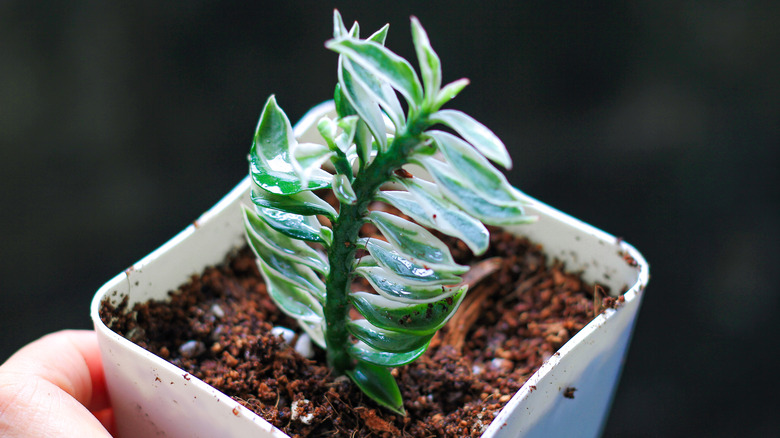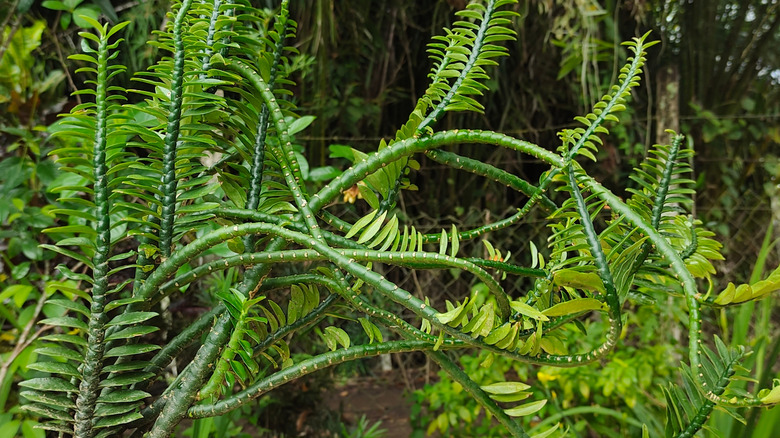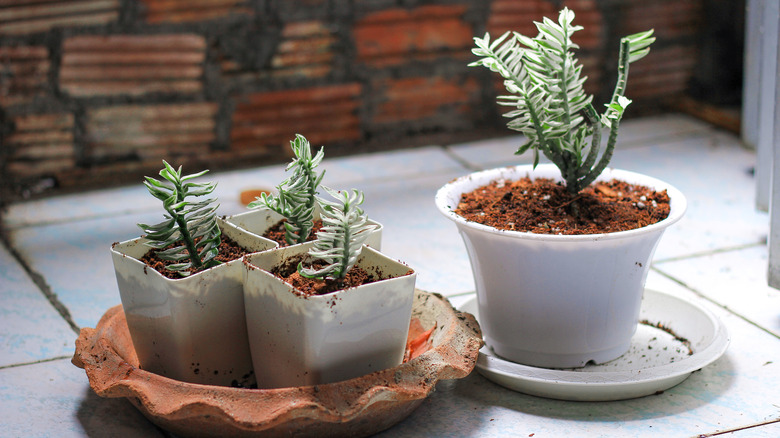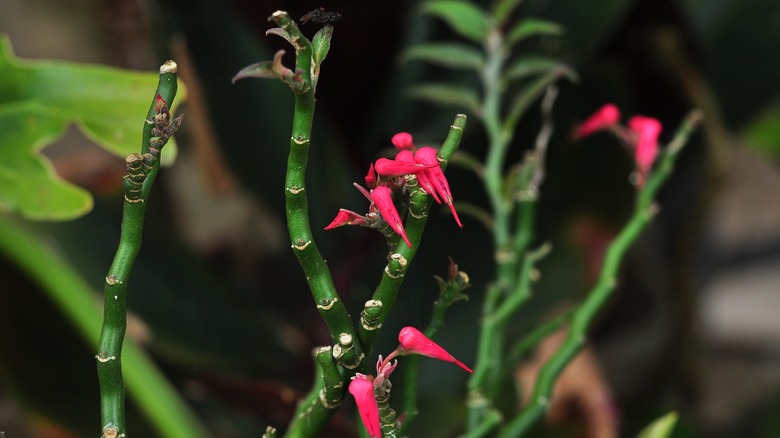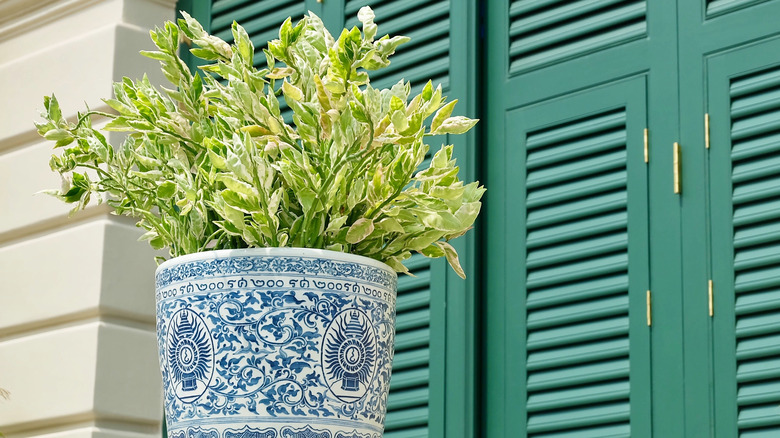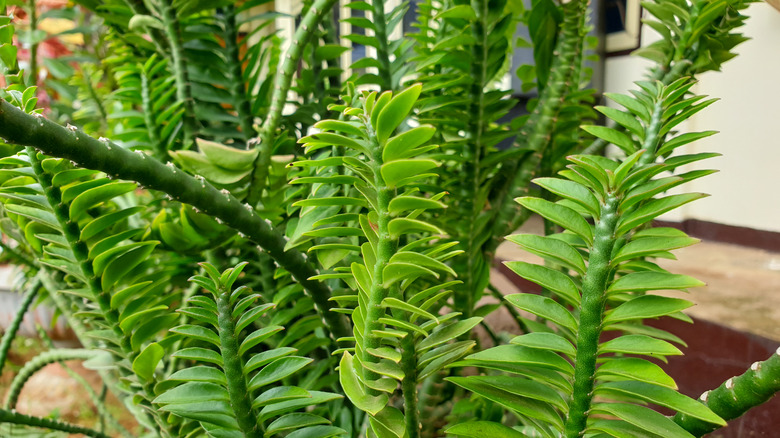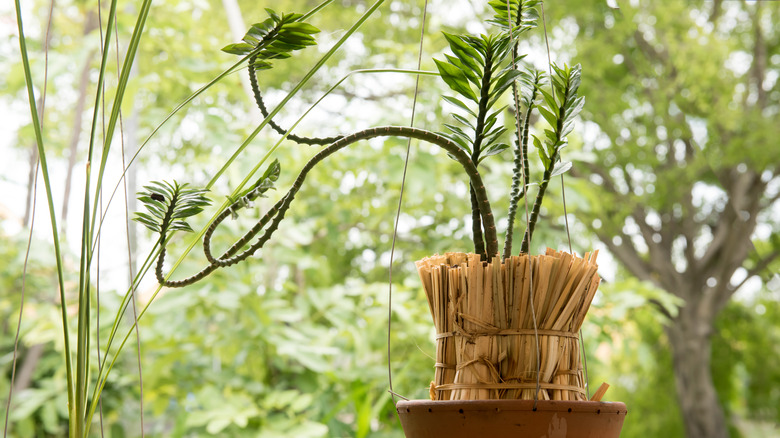How To Care For A Devil's Ribcage Plant
The devil's ribcage plant, with botanical names Euphorbia tithymaloides and Pedilanthus tithymaloides, is a succulent native to tropical and subtropical climates in North and Central America, according to The Spruce. Also known as Japanese poinsettia, Persian lady slipper, zig-zag plant, red bird flower, fiddle flower, and variegated devil's backbone, the various nicknames come from the plant's unique growth pattern, sporting one thick stem with leaves jutting out either side like a ribcage.
The unique-looking succulent is quite a fun plant and blooms in white, green, pink, or red. While it contains real flowers, it also produces red leaf bracts, which some gardeners refer to as slipper flowers because of their shoe-like form. Devil's backbone can be grown as a landscape plant in frost-free areas where it develops into a shrub from 6 to 8 inches. The plant is also incredibly easy to care for. Here's what you need to know about growing and caring for it.
How to use devil's ribcage plant in garden
According to MasterClass, the devil's ribcage succulent is native to tropical and subtropical climates and grows best in USDA hardiness zones 9 and 10. If you live in those zones, the devil's ribcage plant can be grown as a perennial. If not, it would be unwise to plant it in the ground, as it likely won't survive the winter. However, that doesn't mean it can't be a part of your garden design; it is totally possible to bring it outdoors in the warmer summer months.
These plants can grow to be decently large and wide and prefer semi-shaded conditions. If you are growing the plant in a container, this shouldn't be that much of an issue, as you can easily move it if you notice it's getting too much sun. For those planting it in-ground, though, consider growing a tall tree or plant alongside the devil's ribcage. Whether potted or in-ground, a few companion plant recommendations from Costa Farms include rex begonias, snake plants, and crotons.
How to grow devil's ribcage plant
Devil's ribcage plants are quite popular among houseplant and succulent lovers and are easy enough to find at garden centers and plant stores. However, once you have a fully grown, mature, and healthy plant, it can be tempting to want more. So save your money and a trip to the garden center by learning how to propagate this unique shaped succulent. Succulent propagation is a very similar process to regular house plant stem cutting propagation but still a bit different.
To begin, MasterClass recommends obtaining a cutting using clean and sharp shears — emphasis on sharp, as a clean cut will help the plant heal from the wound faster — going as far down the plant as you can. This is where this process differs a little. Instead of immediately rooting the plant, let it sit for a few days to even a couple of weeks until the cuts scab over. Succulents store water in their leaves, and attempting propagation while they still have leftover water can lead to root rot. Once scabbed over, prepare a small container with a potting soil mix specifically for cacti or succulents. Consider adding in a bit of perlite, too, for extra drainage. Dip the cut end in rooting powder and plant. Keep watered and a little more humid than usual, and in a few weeks to a month, gently tug on the plant. If it resists, roots have developed. If not, it needs a little more time.
How to care for devil's ribcage plant
Caring for a devil's ribcage plant is quite easy, especially for those familiar with routine succulent care. Despite being native to a tropical environment, it still functions similarly to the average succulent. Beginning with light, this plant prefers bright indirect light when planted indoors. An east or west-facing window is ideal if it's out of direct morning and evening sun rays. North-facing windows are okay, but be sure to place the plant directly next to the window. South-facing windows are also fine, as long as the pot is positioned away from direct sun (via The Spruce).
Devil's ribcage succulents don't like being moist or overly wet — be conservative on watering, only doing so when it seems totally dry. Alternatively, lightly mist it from time to time, replicating how the plant naturally receives water. Keep the plant away from cold windows or drafty areas like under a vent, as they don't do well in the cold. Finally, feed once every two to four weeks with a succulent or cactus fertilizer during the growing season.
Devil's ribcage plant varieties
The devil's ribcage plant is a member of the Euphorbia genus, also commonly known as spurge. The genus includes 2,100 different species of plants, and the common name comes from multiple plants' natural laxative effects (via Britannica). The members of this genus can grow as creeping herbs and ground cover, shrubs, and even trees and have a variety of appearances and textures. Here are just a few common types of euphorbia, or spurge, courtesy of Balcony Garden Web:
- Poinsettia (Euphorbia pulcherrima) — This common Christmastime flower is probably one of the most popular types of spurge, bearing star-shaped red, pink, or white flowers.
- Crown of thorns (Euphorbia milii) — This euphorbia species is a flowering succulent and produces small thorns, as the name would suggest.
- Donkey tail (Euphorbia myrsinites) — This plant grows as a creeping perennial and is quite popular as ground cover or garden decoration in cooler climates, growing best in zones 5 through 9.
- False globose (Euphorbia pseudoglobosa) — This is a very unique-looking type of spurge, being both a dwarf and spineless species that grows small, round globe-shaped stems.
- Basketball euphorbia (Euphorbia obesa) — This variety gets its common name from its circular shape with markings similar to a basketball and is most commonly grown as a houseplant.
Is devil's ribcage plant toxic?
As stated before, the devil's ribcage plant belongs to the Euphorbia genus, which is a very toxic plant. While humans aren't likely going to be munching on the plant's leaves anytime soon, handling the plant improperly can result in serious injuries. According to Edinburgh News, euphorbia plants produce a white, milky sap that is a potent skin irritant. So if you're handling the plant indoors and come into contact with the sap, it can irritate and inflame the skin. The sap also makes you photosensitive, though, which means handling it in the sun can result in painful blisters.
The real threat is getting it in your eyes, which at best will result in irritation and conjunctivitis but can lead to pus in the eyes and even blindness. It is highly advised to wear gloves and protective eyewear when handling the plant and wash your hands thoroughly after touching it. Be extra careful to keep the plant away from small children. The sap is also toxic to cats and dogs, warns PetMD. It can result in mild to severe gastrointestinal issues (vomiting, diarrhea, decreased appetite, etc.) when ingested. The sap is also a skin and eye irritant to pets. Therefore, it is generally advised not to get any plant in this genus if you have pets, but if you do, be very careful to keep it away from them and call the vet immediately if they come in contact with it.
How to repot the devil's ribcage plant
It is a good rule of thumb to replant the devil's ribcage plant once every three years, advises The Spruce. The main reason to repot so frequently is to refresh the soil, which will have lost most of its nutrients in that time frame. It's also a great opportunity to check for root rot, fungus growth, and pests. If you notice roots are growing out of the pot's bottom and/or top, it's also a good idea to size up the container, anywhere from 2 to 4 inches. For better drainage, opt for an unglazed clay pot.
Begin by removing the plant from its current pot, breaking up the roots, removing all the old dirt, and looking for irregularities. Then, prepare the pot with a small layer of soil to cover the drainage hole. Devil's ribcage plants prefer rich and well-draining soil. Any regular potting mix will be fine, but a cactus or succulent-specific mix is ideal. Incorporate vermiculite, peat moss, and sand for extra drainage, nutrients, and moisture balance. Add the plant to the pot, making sure it's sitting at the same depth as it was before. Fill with soil and water, and let drain thoroughly.
